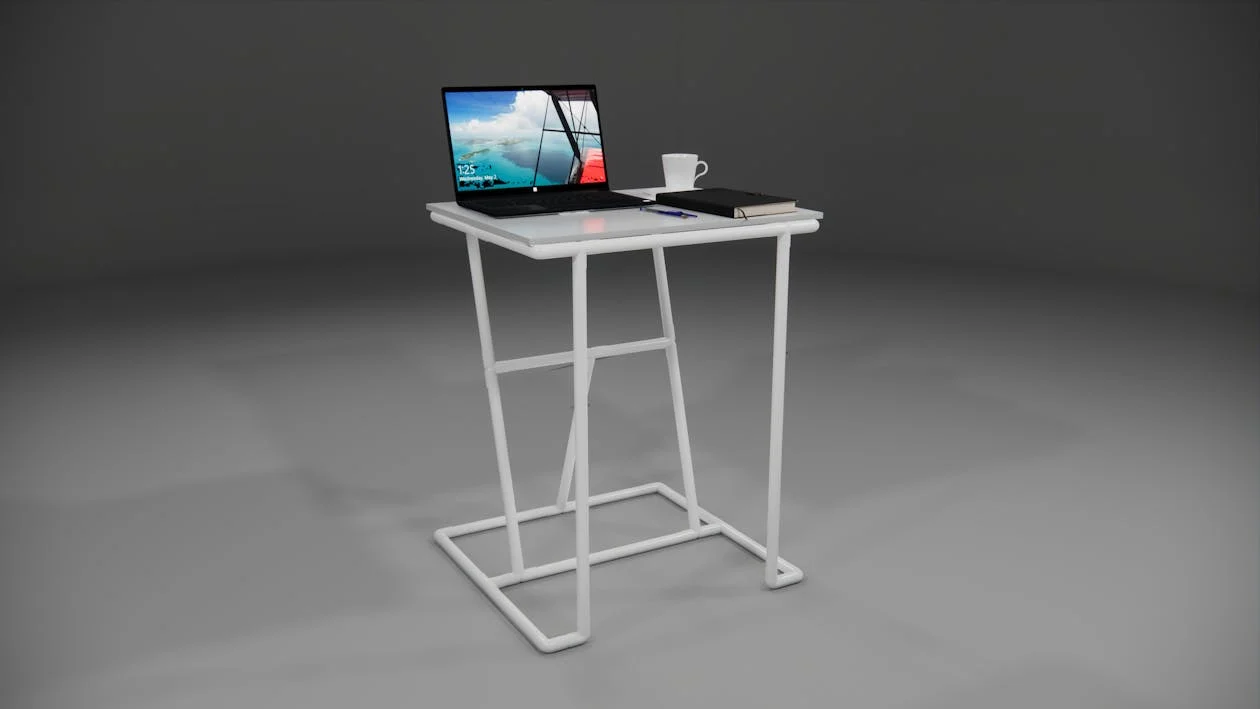10 Steps to Master Ergonomic Workspace Setup for Small Spaces
Creating a comfortable, productive workspace in a small area is no small feat, but with the right ergonomic tips, it’s completely achievable. This guide covers everything you need to design an ergonomic workspace that maximizes both comfort and efficiency, even in tight quarters.
Why Ergonomics Matter in Small Workspaces
Creating a functional and comfortable workspace in a compact area might seem challenging, but it’s crucial for your health, productivity, and overall well-being. An Ergonomic Workspace Setup for Small Spaces ensures that you can work efficiently while minimizing discomfort and health risks. Many people underestimate the impact of ergonomics, but poor workspace design can lead to long-term problems like musculoskeletal disorders and reduced efficiency.
The Impact of Poor Ergonomics
Poor ergonomics doesn’t just affect your physical health; it can also hurt your mental well-being and productivity. Here’s why:
- Physical Discomfort: Cramped, non-ergonomic workspaces often result in back pain, neck strain, and eye fatigue. For individuals working from home in small apartments or shared spaces, the risk is even higher without a proper Ergonomic Workspace Setup for Small Spaces.
- Reduced Productivity: Discomfort leads to distractions, fatigue, and reduced focus. An ergonomically designed workspace eliminates these barriers, ensuring you can work at your best.
- Long-Term Health Issues: If left unaddressed, discomfort caused by poor ergonomics can lead to more serious conditions, including repetitive strain injuries (RSIs) and carpal tunnel syndrome.
Step-by-Step Guide to Creating the Perfect Ergonomic Workspace
Now that you understand why ergonomics matter in small spaces, let’s break down the key steps to create your ideal ergonomic workspace setup.
Step 1: Evaluate Your Space
Start by evaluating your available area. Measure the dimensions of your workspace, note any sources of natural light, and identify unused vertical spaces. Knowing your constraints helps you design a tailored Ergonomic Workspace Setup for Small Spaces that fits perfectly within your environment. This first step allows you to make informed decisions about your furniture and layout.
Step 2: Choose the Right Desk
A desk is the cornerstone of your ergonomic setup. In a small space, it’s essential to choose a compact desk designed for limited areas. Look for:
- Wall-mounted desks to save floor space.
- Foldable desks that can be tucked away when not in use.
- Multi-purpose desks with built-in storage to minimize clutter and maximize functionality.
By choosing the right desk, you’ll set the foundation for an efficient and comfortable Ergonomic Workspace Setup for Small Spaces.
Step 3: Invest in an Ergonomic Chair
An ergonomic chair is essential to your comfort and health. For a small space:
- Opt for chairs with adjustable height and lumbar support to ensure proper posture.
- Consider slim-profile chairs that fit neatly under desks to save space.
- Armless chairs are a good option for better space utilization, especially in tight quarters.
A chair with proper support will make a significant difference in reducing discomfort over long hours of work.
Step 4: Optimize Your Monitor Placement
Proper monitor placement is critical for reducing neck strain. For an effective Ergonomic Workspace Setup for Small Spaces:
- Place your monitor at eye level to keep your neck in a neutral position.
- Use a monitor stand or stack books to elevate the screen if necessary.
- Position the monitor 20-30 inches away from your eyes, and tilt the screen slightly upward to avoid glare.
These adjustments help maintain proper posture and reduce strain during long hours of computer work.

Step 5: Arrange Your Keyboard and Mouse
Ensure your keyboard and mouse are positioned to maintain a natural wrist angle. This will reduce strain on your arms and wrists:
- Use an ergonomic keyboard that promotes a neutral wrist position.
- Place the mouse at the same height as the keyboard for comfort.
- Consider using a wrist rest to support your hands during typing and mouse use.
Proper alignment here is vital for reducing discomfort and enhancing productivity.
Step 6: Utilize Vertical Space
Maximize your small workspace by using vertical space:
- Install shelves above your desk to store books and supplies.
- Use pegboards to hang tools, headphones, or other items.
- Add wall-mounted organizers for quick access to essentials like pens or paperwork.
Going vertical helps keep your desk uncluttered while ensuring everything is within reach.
Step 7: Manage Cables Effectively
A clutter-free workspace is key to maintaining focus and efficiency. Here’s how you can manage cables:
- Use cable clips or cable sleeves to bundle wires neatly.
- Install an under-desk cable tray to keep cords out of sight.
- Label your cables for easy identification when you need to unplug or reconfigure your workspace.
Cable management helps maintain a clean and organized environment, reducing distractions.
Step 8: Incorporate Proper Lighting
Proper lighting is crucial for both comfort and productivity. For a well-lit Ergonomic Workspace Setup for Small Spaces:
- Position your desk near a window to take advantage of natural light.
- Use an adjustable desk lamp to illuminate your workspace during late hours.
- Ensure that your monitor is positioned perpendicular to light sources to avoid glare.
Good lighting reduces eye strain and boosts mood, creating a more comfortable and efficient environment.
Step 9: Add Personal Touches
Personalizing your workspace makes it feel inviting and motivating. Consider adding:
- Small plants for natural air purification and a calming atmosphere.
- Motivational quotes or artwork to inspire creativity and positivity.
- Decor that aligns with your personality, such as favorite colors or meaningful objects.
These touches can make your workspace a place you genuinely enjoy spending time in.
Step 10: Maintain Your Workspace
To ensure continued comfort and productivity, maintain your Ergonomic Workspace Setup for Small Spaces:
- Regularly declutter your desk to maintain focus and efficiency.
- Adjust your setup as needed to accommodate new tools or work habits.
- Periodically reassess your ergonomics to make sure your space remains comfortable.
Routine upkeep ensures that your workspace stays functional and efficient in the long run.
Benefits of an Ergonomic Workspace
Investing in an Ergonomic Workspace Setup for Small Spaces brings multiple advantages, even in the tightest corners:
- Better Posture: Properly adjusted desks and chairs help you maintain a healthy posture.
- Increased Efficiency: An organized and ergonomic setup reduces the time spent searching for items or adjusting your position.
- Healthier Lifestyle: With better ergonomics, you’ll experience fewer aches and pains, allowing you to focus on work without distractions.
Key Principles of Ergonomic Design
Designing an Ergonomic Workspace Setup for Small Spaces requires careful planning and understanding of core ergonomic principles. These principles ensure that your setup supports your body, productivity, and the available space.
Adjustability
Flexibility is the cornerstone of ergonomics. Choose adjustable furniture that can adapt to your height and posture. For instance:
- Chairs: Look for options with adjustable seat height, backrest angle, and lumbar support.
- Desks: Adjustable desks allow you to alternate between sitting and standing, even in a limited area.
Minimalism and Functionality
An Ergonomic Workspace Setup for Small Spaces thrives on simplicity. Keep your workspace clutter-free by prioritizing essential items. Multi-purpose furniture, such as desks with built-in storage, can combine functionality with minimalism.
Proper Lighting
Good lighting is vital for both comfort and efficiency. Your Ergonomic Workspace Setup for Small Spaces should ideally include:
- Natural Light: Position your workspace near a window to reduce eye strain.
- Task Lighting: Use adjustable desk lamps to focus light on your work area.
Choosing the Right Furniture for Small Spaces
When planning an Ergonomic Workspace Setup for Small Spaces, selecting the right furniture can make or break your design. Compact, multi-functional, and ergonomic pieces are key to making the most of limited space.
Compact Desks
A desk is the heart of your workspace. For an Ergonomic Workspace Setup for Small Spaces, consider:
- Wall-Mounted Desks: These save floor space while providing a sturdy work surface.
- Foldable Desks: Perfect for small apartments, these can be stored away when not in use.
- Desks with Storage: Look for desks with drawers or shelves to minimize clutter.

Ergonomic Chairs for Limited Areas
An ergonomic chair is non-negotiable for a healthy workspace. For a small space:
- Opt for armless chairs to fit under desks more easily.
- Prioritize features like lumbar support, adjustable height, and padded seating.
- Consider slim-profile chairs that offer comfort without bulk.
Multi-functional Furniture
Multi-functional furniture is essential for an Ergonomic Workspace Setup for Small Spaces. Examples include:
- Standing Desk Converters: Transform any surface into a standing desk.
- Storage Ottomans: Use them as seating and to store office supplies.
Space Optimization Tips
An effective Ergonomic Workspace Setup for Small Spaces relies on clever space management. Here’s how you can make the most of a small area:
Vertical Storage Solutions
Use the walls to your advantage:
- Install shelves above your desk to store books, files, or decor.
- Pegboards can hold items like headphones, stationery, or tools.
- Wall-mounted organizers keep essentials accessible without crowding your desk.
Cable Management
Messy cables can make even the best Ergonomic Workspace Setup for Small Spaces look untidy. Keep wires under control by:
- Using cable clips or zip ties to bundle cords.
- Installing a cable management tray under your desk.
- Labeling cables for easy identification.
Ergonomic Tools and Accessories
The right tools can elevate your Ergonomic Workspace Setup for Small Spaces, making it both functional and comfortable.
Monitor Stands and Risers
A monitor placed at eye level prevents neck strain. Consider:
- Adjustable monitor risers to customize height.
- Dual-purpose stands with built-in storage to save space.
Keyboard and Mouse Placement
Proper keyboard and mouse placement is critical in an Ergonomic Workspace Setup for Small Spaces:
- Use an ergonomic keyboard to keep your wrists straight.
- A vertical mouse reduces strain on your arm and wrist.
Footrests and Cushions
Small accessories like footrests and cushions can improve posture and reduce strain.
- Compact Footrests: Provide leg support without taking up much space.
- Seat Cushions: Add comfort and support, especially for longer work hours.
Setting Up Your Workspace Step-by-Step
Creating an Ergonomic Workspace Setup for Small Spaces doesn’t have to be complicated. With a strategic approach, even the tiniest area can become a productive, comfortable haven. Follow these steps to design an ergonomic workspace that enhances your efficiency and well-being.
1. Assess Your Space
Before jumping into the setup, take a moment to analyze your workspace. Understanding your space’s limitations and strengths is essential for creating an efficient Ergonomic Workspace Setup for Small Spaces:
- Measure Dimensions: Note the available area to ensure your furniture fits well without overcrowding.
- Identify Problem Areas: Are there areas with poor lighting or limited access?
- List Priorities: Decide what’s non-negotiable, such as a desk, ergonomic chair, and storage options.
By knowing your space, you can better allocate resources and avoid common mistakes in designing an Ergonomic Workspace Setup for Small Spaces.
2. Layout Planning
A well-organized layout is the backbone of an effective workspace. Small spaces require extra thought to ensure every inch is used efficiently:
- Functional Flow: Place essential items, such as your laptop and documents, within easy reach to minimize movement.
- Lighting Optimization: If possible, set up near natural light sources to reduce eye strain and improve mood.
- Zoning: Divide your space into zones for work, storage, and relaxation. For example, use a corner for your workstation and install vertical storage to organize supplies.
Remember, a thoughtful layout can transform any area into an ergonomic haven.
3. Personalization
An Ergonomic Workspace Setup for Small Spaces should reflect your personality while maintaining functionality. Adding personal touches makes the space more inviting:
- Decor That Inspires: Include plants, framed quotes, or desk organizers in your favorite colors.
- Comfort Enhancements: Use a soft desk mat or a small rug to add texture and warmth.
- Mood Boosters: Display items that motivate you, like photos, souvenirs, or awards.
Personalization adds charm to your workspace while keeping you motivated and focused.

Common Mistakes to Avoid
An effective Ergonomic Workspace Setup for Small Spaces avoids these common pitfalls:
1. Overcrowding
Overloading a small space with too many items can quickly lead to frustration:
- Declutter Regularly: Remove non-essential items to free up desk space.
- Invest in Smart Storage: Use stackable boxes, wall-mounted shelves, or under-desk drawers to manage clutter.
2. Ignoring Ergonomic Basics
Skipping ergonomic essentials can lead to discomfort and inefficiency:
- Avoid using a chair without adjustable lumbar support.
- Ensure your desk height allows for a 90-degree elbow angle while typing.
- Don’t overlook the need for a monitor positioned at eye level to prevent neck strain.
Budget-Friendly Ergonomic Setup Ideas
You don’t need a fortune to create a functional Ergonomic Workspace Setup for Small Spaces. Here’s how you can set up a comfortable workspace on a budget:
1. DIY Ergonomic Solutions
Save money by repurposing items you already own:
- Monitor Elevation: Use books, a sturdy box, or even a stackable organizer to lift your monitor.
- Wrist Rests: A rolled-up towel or small pillow can serve as a temporary wrist rest.
- Foot Support: Turn an old shoebox or storage bin into a footrest to maintain proper posture.
2. Affordable Furniture and Tools
Find ergonomic furniture and tools without breaking the bank:
- Desks: Opt for compact desks with built-in shelves or wall-mounted options to save space and cost.
- Chairs: Shop at IKEA, Amazon, or local stores for affordable ergonomic chairs with adjustable features.
- Accessories: Look for deals on monitor stands, laptop risers, and desk organizers.
3. Utilize Vertical Space
Maximize your workspace by installing shelves, pegboards, or hanging organizers. This keeps your desk clear while ensuring items are within easy reach.
Bonus Tips for a Perfect Ergonomic Workspace Setup for Small Spaces
- Use Foldable Furniture: Choose foldable desks or chairs that can be stored away when not in use.
- Multi-purpose Items: Consider desks with integrated storage or ottomans that double as seating.
- Cable Management: Tidy up cables with clips, sleeves, or under-desk trays to avoid tangles.
- Standing Desk Options: If possible, invest in a compact standing desk converter to alternate between sitting and standing.
Conclusion: Optimize Your Small Space with Ergonomics
An ergonomic workspace setup for small spaces is essential for achieving comfort, productivity, and health. By following the steps in this guide, you can transform even the tiniest area into an efficient, comfortable, and supportive workspace. With the right furniture, lighting, and accessories, you can minimize discomfort, improve focus, and boost productivity.
Investing in an ergonomic workspace doesn’t just enhance your physical well-being—it also helps you stay productive and focused for longer periods. No matter how limited your space is, an ergonomic setup can make a world of difference in your work-life balance.
FAQ
1. What is an ergonomic workspace?
It’s a setup designed to improve comfort, productivity, and posture.
2. How do I choose ergonomic furniture for small spaces?
Look for compact, adjustable, and multifunctional pieces.
3. Are ergonomic tools expensive?
Not necessarily. Many affordable options and DIY hacks are available.
4. How high should my monitor be?
The top of the screen should be at eye level.
5. Can I create an ergonomic workspace on a budget?
Absolutely! Use DIY solutions and shop for budget-friendly items.
6. What are the top ergonomic accessories for small spaces?
Monitor risers, ergonomic keyboards, and compact footrests are great additions.
7. Why is lighting important in ergonomic design?
Proper lighting reduces eye strain and boosts productivity.
8. How can I manage cables in a small workspace?
Use cable clips or trays to organize and conceal wires effectively.


